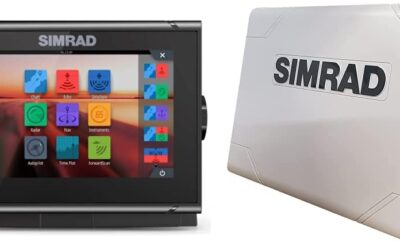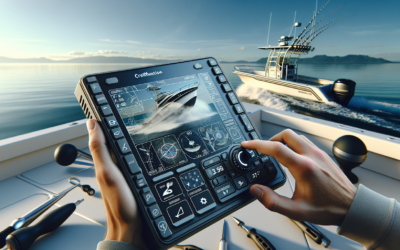In the vast world of angling, choosing the perfect installation method for your fish finder is key to maximizing your catches every time you head out to sea. “Mounting Methods: Pros And Cons Of Different Fish Finder Installations” aims to give you helpful insights into which techniques work best for various fishing situations, ensuring you find the optimum balance between efficiency and convenience. From discussing fixed mounts to portable units, this article is crafted to guide you through the intricacies of fish finder installations, aiming to improve your angling adventure.
Transom Mount Method
Defining the Transom Mount Method
The transom mount method refers to placing the fish finder’s transducer on the back of your boat or “transom.” This position exposes the instrument to the water directly, providing a clear line of sight underneath your watercraft. This method of mounting is widely used, being part of the kit in most fish finders.
Pros of Transom Mount Method
A significant advantage of the transom mount method is simplicity. The process of attaching the transducer to the transom is relatively straightforward, making this form excellent for beginners. The transom mounted transducer provides solid performance. It’s a great option for small boats that don’t reach high speeds as the mount allows for the depth reading to remain continuous.
Cons of Transom Mount Method
Conversely, the transom mount method has some limitations. For instance, it may not work as effectively at high speeds. More so, the mount’s exposed position makes it vulnerable to damage from docking or debris in the water.
Ideal Scenarios for Transom Mount Method
The transom mount method is best suited for small to midsize craft which do not typically reach high speeds. It’s also a great choice for kayaks and pontoon boats.
In-hull Mount Method
Defining the In-hull Mount Method
In-hull mount method involves placing the transducer inside the hull of the boat. In this method, the transducer sends signals through the hull itself into the water.
Pros of In-hull Mount Method
A significant benefit of the in-hull mount process is that there’s no direct contact between the transducer and the water. This configuration protects the transducer from potential risks, such as damage from underwater debris or impacts during docking. Additionally, in-hull mounts allow for use at higher speeds and better performance in choppy waters.
Cons of In-hull Mount Method
However, in-hull mounts are not without disadvantages. For one, the transducer must transmit signals through the hull material, which can limit signal strength. This method can also be tricky to install, requiring careful consideration to avoid air bubbles that could interfere with the signal.
Ideal Scenarios for In-hull Mount Method
In-hull mounting method is ideal for larger, faster boats that travel in a variety of conditions. If your boat hull is thick and solid, have no fear of drilling holes, and are prepared to put in the installation effort, this method might be ideal.
Trolling Motor Mount Method
Defining the Trolling Motor Mount Method
The trolling motor mount method refers to attaching the transducer directly to your vessel’s trolling motor. This method often requires a specific type of transducer that fits on the trolling motor.
Pros of Trolling Motor Mount Method
One of the biggest advantage of this method is the stealth with which you can move, without spooking fish under the water. Secondly, you don’t have to drill holes in the boat for mounting. Lastly, with placement on the trolling motor, the transducer is at the front of the boat, offering an unobstructed view under the water.
Cons of Trolling Motor Mount Method
On the downside, this method limits your choices of transducer type. It strictly requires a trolling motor compatible transducer. Plus, turning or lifting up the motor could temporarily interrupt your scanning.
Ideal Scenarios for Trolling Motor Mount Method
This method is an excellent option for small boats or kayaks where stealth is required while moving slowly or staying put in one place.
Thru-Hull Mount Method
Defining the Thru-Hull Mount Method
A thru-hull mount involves installing the transducer through the hull of the vessel. Here, a hole has to be drilled into the boat’s hull, into which the transducer fits snugly.
Pros of Thru-Hull Mount Method
Optimally, thru-hull mounts provide excellent performance regardless of speed or water conditions. They tend to provide the steadiest and highest quality readings and leave no chance for air bubbles to get in the way.
Cons of Thru-Hull Mount Method
However, these come with some obvious cons such as a more complex installation process which includes drilling a hole right through the hull. Moreover, maintenance and any future replacements also require more work and a haul-out of the boat.
Ideal Scenarios for Thru-Hull Mount Method
Thru-hull is best suited for larger boats where the owner is willing to take on the installation and maintenance challenges, or marine professionals are commissioned to do the work.
Portable Mount Method
Defining the Portable Mount Method
The portable mount method stands exactly as it sounds. The transducer is attached to a portable device, which can be temporarily placed in the water when needed and taken out when it’s not.
Pros of Portable Mount Method
The most prominent advantage is certainly the flexibility this offers. You can use your fish finder on different boats without needing multiple installations. It’s also helpful for rentals, or if you don’t want to modify your boat in any way.
Cons of Portable Mount Method
The portable method, however, may not provide as steady or reliable readings as the more permanent mount methods due to shifting and potential water turbulence around the device.
Ideal Scenarios for Portable Mount Method
If you switch boats often, have a rental boat, or don’t want to make any physical adjustments to your vessel, a portable fish finder is a good option.
Shoot-thru Mount Method
Defining the Shoot-thru Mount Method
Shoot-thru method involves mounting the transducer inside the hull, similar to the in-hull method. However, rather than attaching to the hull, the transducer “shoots” the signal through the hull from a free-floating position.
Pros of Shoot-thru Mount Method
In terms of benefits, the shoot-thru method also helps protect the transducer from potential damage and allows for usage at higher speeds. There is also no need to drill holes in your hull, making it a non-invasive option.
Cons of Shoot-thru Mount Method
The downside, however, is a potential for degraded signal due to the signal transmission through the hull and the surrounding water inside. It also requires a smooth, even hull for the best performance.
Ideal Scenarios for Shoot-thru Mount Method
This method is optimal for those who want the benefits of the in-hull method without drilling holes into the boat, especially boat owners with smooth bottomed hulls.
Comparative Analysis of All Methods
Comparing User-friendliness Across All Methods
When it comes to user-friendliness, nothing beats the transom and portable methods with easy installation and simple use. On the other hand, the thru-hull, in-hull, and shoot-thru methods demand more effort for installation and aligning the transducer but often provide the most steady, reliable readings.
Comparing Cost-effectiveness Across All Methods
In terms of cost-effectiveness, the transom, trolling motor, and portable methods are often the less expensive options due to less complex installation requirements. Mounted methods like in-hull or thru-hull can incur extra costs due to their more difficult, intricate installation process.
Comparing Versatility Across All Methods
Portable and transom mount methods provide the most versatility with an opportunity to use the fish finder on different boats, with the portable method being the absolute winner.
Country-Specific Regulations and Recommendations
Understanding Local Laws for Fish Finder Installations
Before you decide on your fish finder installation, it’s essential to investigate your local laws and regulations. Some areas might have certain restrictions or requirements for marine equipment installations, or specific guidelines for different bodies of water.
Impact of Local Ecosystems on Choice of Installation Method
Also, consider the type of water bodies you predominantly boat in. They could influence your choice of installation. Choppy seas versus calm lakes, shallow waters versus deep seas – these factors can impact how well each mounting method performs.
Longevity and Maintenance of Fish Finder Installations
How Mounting Method Impacts Longevity
The mounting technique can considerably affect your fish finder’s lifespan. More protected methods like the in-hull or shoot-thru can potentially offer more longevity due to the transducer’s protected positioning.
Maintenance Tips for Each Mounting Method
Regular cleaning and upkeep are crucial to extend the life of your fish finder. Make sure to clean the transducer regularly, check for any physical damages or internal software issues. For methods that involve drilling, make sure to check the seals around the holes regularly for any leakage.
Emerging Trends in Fish Finder Installations
New Technological Innovations
Fish finder installations are continually evolving, with lighter, compact, yet more potent designs coming into the market. Additionally, technologies like multi-beam scanning and digital processing are revolutionizing the way we use fish finders.
Shifting Consumer Preferences
Consumer preferences are also evolving, with more boaters preferring non-invasive methods that offer easy installation and use, like portable or trolling motor methods.
Effect of Climate Change on Fish Finder Installations
Climate changes can affect marine life behavior, therefore influencing how we use fish finders. Innovations are focusing on developing mounting methods and fish finders that can withstand harsher conditions, deliver accurate readings across different climates, and adapt to changing marine ecosystems.
In conclusion, choosing the right mounting method for your fish finder installation depends on several factors – your boat type, boating speed, local laws and ecosystems, and your comfort with installation and maintenance. Consider all these aspects, balance the pros and cons, and make an informed decision that meets your unique needs.









